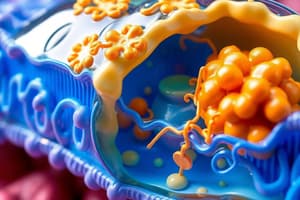Podcast
Questions and Answers
What is required for the movement of potassium into an animal cell?
What is required for the movement of potassium into an animal cell?
- An energy source such as ATP (correct)
- High cellular concentrations of potassium
- A cotransport protein
- Low cellular concentrations of sodium
Which molecule is most likely to diffuse quickly across a lipid bilayer membrane?
Which molecule is most likely to diffuse quickly across a lipid bilayer membrane?
- H2PO4–
- Glucose
- H2O
- O2 (correct)
Which of the following processes describes the incorporation of material into a cell?
Which of the following processes describes the incorporation of material into a cell?
- Simple diffusion
- Facilitated diffusion
- Endocytosis (correct)
- Bulk flow
What is the primary reason that some substances require specific transport proteins to cross the membrane?
What is the primary reason that some substances require specific transport proteins to cross the membrane?
Which of the following is NOT a characteristic of facilitated diffusion?
Which of the following is NOT a characteristic of facilitated diffusion?
What does Singer and Nicolson's fluid mosaic model propose about the membrane structure?
What does Singer and Nicolson's fluid mosaic model propose about the membrane structure?
Which factor increases the fluidity of an animal cell membrane at room temperature?
Which factor increases the fluidity of an animal cell membrane at room temperature?
Which process enables solutes to move against their concentration gradient?
Which process enables solutes to move against their concentration gradient?
What function would be impaired in an animal cell lacking oligosaccharides on its plasma membrane?
What function would be impaired in an animal cell lacking oligosaccharides on its plasma membrane?
Which type of protein is not necessarily found associated with the plasma membrane?
Which type of protein is not necessarily found associated with the plasma membrane?
What is the likely outcome for a plant cell submerged in a very hypotonic solution?
What is the likely outcome for a plant cell submerged in a very hypotonic solution?
Which of the following factors affects the rate of diffusion through a selectively permeable membrane?
Which of the following factors affects the rate of diffusion through a selectively permeable membrane?
What is the primary role of proteins embedded in the fluid mosaic model of membranes?
What is the primary role of proteins embedded in the fluid mosaic model of membranes?
Study Notes
### Fluid Mosaic Model
- The Fluid Mosaic Model describes cell membranes as consisting of protein molecules embedded in a fluid bilayer of phospholipids.
Membrane Fluidity
- Membrane fluidity is influenced by the composition of fatty acid tails in phospholipids.
- Longer chain fatty acids make the membrane less fluid.
- The presence of cis-unsaturated and polyunsaturated fatty acids increases membrane fluidity.
- Trans-unsaturated fatty acids decrease fluidity.
- Cholesterol can affect membrane fluidity depending on temperature: at high temperatures, it reduces fluidity; at low temperatures, it maintains fluidity.
### Types of Membrane Transport
- Passive transport does not require energy input and relies on the concentration gradient.
- Simple diffusion involves the movement of a substance across a membrane from an area of high concentration to an area of low concentration.
- Facilitated diffusion requires the assistance of transport proteins to move substances across the membrane.
- Active transport requires energy input, often in the form of ATP, to move substances against their concentration gradient.
- Sodium-potassium pump is an example of active transport that moves sodium ions out of the cell and potassium ions into the cell against their concentration gradients, using the energy from ATP hydrolysis.
- Some active transport coupled with the movement of another molecule down its concentration gradient, known as cotransport.
### Membrane Proteins and Function
- Recognition proteins are involved in cell-cell recognition, allowing cells to identify and interact with each other.
- Receptor proteins bind to specific signaling molecules, triggering cellular responses.
- Channel proteins form pores through the membrane, allowing the passage of specific ions or molecules.
- Transport proteins facilitate the movement of molecules across the membrane.
- Plasma proteins are not necessarily associated with the plasma membrane.
### Plant Cells in Hypotonic Solutions
- When a plant cell is submerged in a hypotonic solution, the water potential of the solution is lower than the water potential inside the cell, causing water to move into the cell.
- This influx of water causes the cell to become turgid, pushing the cell membrane against the cell wall, providing the plant with structural support.
### Factors Affecting Diffusion Rate
- The rate of diffusion across a selectively permeable membrane is influenced by several factors:
- Concentration Gradient: The steeper the concentration gradient, the faster the rate of diffusion.
- Temperature: Higher temperatures increase the rate of diffusion.
- Molecular Size: Smaller molecules diffuse faster than larger ones.
### Endocytosis
- Endocytosis is a process by which the cell takes in material from the external environment by forming vesicles.
- Phagocytosis is the process by which the cell engulfs large particles, such as bacteria or cell debris.
- Pinocytosis is the process by which the cell engulfs fluids and dissolved substances.
- Receptor-mediated endocytosis is a specialized type of endocytosis that involves the binding of specific ligands to receptors on the cell surface.
### Membrane Transport Summary
- Simple Diffusion: movement of molecules down their concentration gradient, no energy required.
- Facilitated Diffusion: movement of molecules down their concentration gradient with the help of transport proteins, no energy required.
- Active Transport: movement of molecules against their concentration gradient, requires energy.
- Bulk Flow: movement of liquids or gasses through a membrane or a tube.
- Endocytosis: uptake of large molecules or particles into a cell by forming vesicles.
- Phagocytosis: uptake of solid particles.
- Pinocytosis: uptake of fluids.
- Receptor-Mediated Endocytosis: intake of specific molecules.
Studying That Suits You
Use AI to generate personalized quizzes and flashcards to suit your learning preferences.
Related Documents
Description
This quiz covers key concepts related to the Fluid Mosaic Model, factors affecting membrane fluidity, and types of membrane transport. Understand the mechanisms behind passive transport and how various factors influence cellular membranes.




